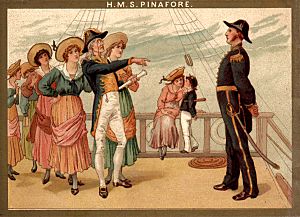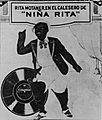Operetta facts for kids
Operetta is a term which started to be used in the 19th century to describe an opera that was not too serious and often full of fun. It is often described as “light opera” (“light” meaning “not serious“). In an opera everything is usually sung. In an operetta there is a lot of spoken dialogue, and songs and dances are added to this. Similar traditions already existed in other countries, e.g. in Germany where the Singspiel tradition was popular (e.g. Mozart’s The Magic Flute).
The operetta tradition started in France and soon spread to Austria and other countries. It remained popular until the mid-20th century, when it gradually turned into musical comedy.
The composer Jacques Offenbach can be thought of as the creator of the operetta tradition. It grew out of the opéra comique which had become quite long and serious. There was a need for shorter, more humorous musical entertainments. Offenbach was composing operettas in the 1850s in Paris. In England such works were often called “comic operas” or “opera comedies”. Then Johann Strauss became very popular in Vienna. He was already very well known in the ballroom, but when he started to write for the theatre he soon became a rival to Offenbach, whose operettas had become very popular in Vienna. Strauss’s operetta Die Fledermaus (“The Bat”) has been performed more than any other operetta. In Spain the Zarzuela was a kind of operetta.
Many people were involved in the creating and performing of operettas. The performers often had to both sing and act very well. Bizet, Chabrier and Delibes all wrote operettas as well as operas and other types of music. In England the operas of Gilbert and Sullivan were a kind of English form of operetta.
One of the most popular of all operettas was Die Lustige Witwe (The Merry Widow) by Franz Léhar. It was produced in 1905 in Vienna. Léhar wrote many other operettas as well. Franz von Suppé is another composer who wrote operettas in the Austrian tradition. The most known Romanian operetta is Crai nou (New moon) by Ciprian Porumbescu.
In the early 20th century the French operetta became less popular as there was more interest in the Viennese operetta. After World War I Berlin was the centre of German operetta. By the middle of the 20th century many composers were writing light operas which were based on American dance band music. These were no longer called “operettas”. The word “operetta” continued to be used for light operas which were more in the style of traditional central European music.
Images for kids
-
The audience at the Théâtre des Bouffes-Parisiens, the birthplace of Jacques Offenbach's operettas (1860)
-
A Columbia Records advertisement for a recording of Rita Montaner in a production of Francisco Alonso's La Calesera, an operetta from the Spanish genre of zarzuela.
-
Die lustige Witwe (The Merry Widow) poster by Franz Lehár
-
Paul Lincke, father of the Berlin operetta
See also
 In Spanish: Opereta para niños
In Spanish: Opereta para niños








